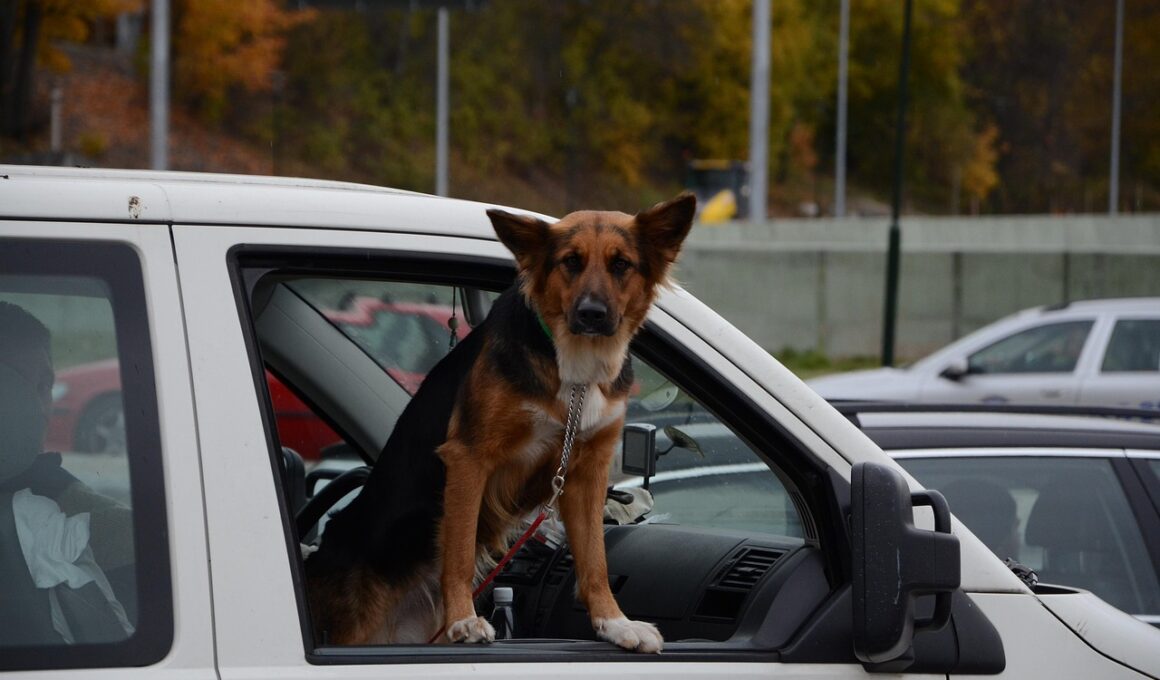The Role of Exercise Before Car Rides to Calm Your Dog
When it comes to car rides, many dogs can feel anxious or restless. This is where exercise plays a crucial role. Engaging your dog in physical activity before a car ride helps burn off excess energy. A well-exercised dog is less likely to jump around or whine during the journey. Exercise promotes the release of endorphins, which can lead to a calmer demeanor. Not all dogs react the same way; observing your pet’s behavior helps determine the right amount of exercise required. Regular walks or play sessions prior to trips can significantly improve their state of mind. Notably, varying activities keeps things fresh and interesting. For instance, including obedience training or agility exercises can further stimulate your dog. Furthermore, practicing calm behaviors after exercise reinforces the desired state you want them to exhibit in the car. Creating a positive association with car rides can also be beneficial. Consider pairing the exercise with their favorite toy or treat. This method builds excitement, making the car ride a more enjoyable experience for both of you. Remember, a tired dog is a happy dog, especially on long journeys.
Understanding Your Dog’s Energy Levels
Each dog has unique energy levels that should be taken into account when planning exercises before car rides. Some breeds are more energetic than others, which can influence the type and duration of exercise. High-energy breeds, such as Border Collies and Australian Shepherds, often require more extensive physical activity to feel settled. In contrast, calm breeds may need less strenuous exercise. Monitoring indicators like restlessness or overexcitement can inform your exercise strategy, which should be adaptable to your dog’s responses. Dogs benefit from both physical and mental stimulation, so consider incorporating engaging activities like puzzle toys or interactive games, alongside physical play. Activities that require problem-solving will help tire them in a different way, creating balance. Remember, the goal is to help them feel more relaxed and ready for their upcoming ride. Also, assess your dog’s stamina and age when designing exercise sessions. Too much exercise before a car ride can lead to fatigue, which may also cause stress. Always observe your dog’s body language during exercises; adapting to their needs will foster a healthier routine and result in more enjoyable car rides.
Calmness is key in preparing your dog for travel. Regular exercise ensures your pet’s overall well-being, reflecting on their travel behavior. Understanding effective exercise types is fundamental. Short, intensive training sessions are fantastic for younger dogs. On the flip side, older dogs might prefer gentler activities. Individual preferences matter; your dog may respond better to fetch than a long run. Moreover, practice soothing commands after exercising for a smoother transition into the car. Having a familiar blanket or toy can enhance comfort and relaxation. Dogs are creatures of habit and thrive in predictable routines, so maintaining consistency is crucial. Combining pre-ride exercise with familiar cues creates a calming environment. Establishing a routine also involves timing; try to exercise your dog a few hours before travel. This allows ample time for rest, reducing any travel-related anxiety. Additionally, each dog is unique in their interaction with car rides based on past experiences. For instance, if your dog associates car rides with enjoyable outings, this can lessen anxiety. Providing safety in the car, such as using a crate or seatbelt, enhances overall comfort while travelling, creating a significantly more pleasant experience for both dogs and their owners.
Preparing for the Car Journey
Preparation goes beyond just exercise. Properly preparing your dog for a car ride involves creating a pleasant atmosphere that can alleviate anxiety. First, ensure that your dog is comfortable in the vehicle. If your dog tends to get motion sickness, consult your vet for possible solutions or medications. Alternatively, using natural remedies, like ginger, can be effective for some dogs. Ensuring your dog has a cozy space in the car is also crucial. Consider your dog’s size and behavior when selecting the right travel gear, whether it’s a carrier or a specific pet seat. Safety should not be overlooked; harnesses and crates can protect your dog and prevent distractions while driving. Teaching your dog to enter and exit the car calmly forms a crucial part of pre-ride training. Incorporate these actions into your routine regularly. Moreover, acclimatizing your dog to short car rides can help ease them into longer trips. Gradually increasing time spent in the car allows for familiarity with the setting, paving the way for peaceful journeys ahead. Available treats can serve as rewards for good behavior during travel, encouraging positive associations with future trips.
Ultimately, establishing a calming pre-ride routine is integral to your dog’s travel readiness. After exercising, observe your dog’s demeanor. Engage them in relaxed behavior, reinforcing serenity before entering the vehicle. Employ commands such as ‘stay’ or ‘sit,’ which can help induce calmness. Lastly, reward them for maintaining composure. Just like humans, dogs benefit from encouragement, particularly in unfamiliar situations. Showing patience and understanding will foster a positive relationship, creating smoother experiences. Additionally, consider your dog’s emotional state. If your dog shows signs of distress, reassess their exercise level or travel conditions. Dogs can mirror their owners’ emotions, making your calmness essential during preparation. The vehicle should become a space of comfort, rather than anxiety. Additionally, consider using calming aids, such as pheromone sprays or anxiety wraps, to promote tranquility. Focusing on pre-ride management really improves overall experiences. Training should not just be about physical activity; mental well-being is equally vital. Tailor your methods to suit your dog’s personality traits and habits. The more traveled your dog becomes, the better they handle excursions. Forming positive relationships around travel ensures lifelong companionship and excitement for adventures ahead.
Long-Term Benefits of Routine
Developing a consistent exercise and training routine is beneficial not just for car rides but for your dog’s overall well-being. Over time, as your dog adapts to routines, you will notice changes in behavior, particularly during travel. The calming influence of exercise encourages a sense of stability in your dog’s life. Regularly following this routine promotes predictability, helping your dog feel secure. If your dog perceives certain situations as normal, such as pre-ride exercises, anxiety levels decrease significantly. Additionally, socialization during these exercise sessions can further enhance their adaptability. Interacting with other pets or people facilitates good behavior and reduces fear-based reactions to novel experiences. Furthermore, sharing these experiences can foster stronger bonds between you and your pup. Every positive encounter reinforces trust, making travel an enhancement to your overall life together. Additionally, long-term exercise boosts physical health, improving mood and energy. A healthy dog is more resilient against stressors, whether on the road or at home. Staying active is important for managing behaviors, ultimately leading to better travels, while regular practice enhances reliability during trips. Keeping your dog happy and healthy ensures memorable journeys for both, filled with mutual enjoyment.
Finally, remember that all dogs possess individual preferences and needs. Regular feedback from your dog is vital in adapting any training or exercise routine. Consequently, every journey becomes a chance to learn about your dog’s character, allowing tailor-made strategies. Your diligence in preparing for car rides pays off, creating smoother travel experiences. Regular reviews of your strategies will also ensure continued improvement in your approach. Concentrate on the aspects that work best for your dog and modify them as conditions change. Every distraction at home or on the road can influence your dog’s behavior; thus, being adaptable is necessary. Always aim for a holistic approach, covering the physical, emotional, and social aspects of your dog’s well-being. Keeping your dog calm and composed starts with you; your energy affects their mood. Ultimately, using exercise wisely shapes how your dog experiences car rides, potentially turning a stressful scenario into an enjoyable adventure. Foster an environment of learning, consistency, and love. With effort, you’ll build trusted patterns that make every car ride an opportunity rather than a challenge, setting the stage for delightful explorations together.
Enhancing the Car Ride Experience
While exercise plays a valuable role in calming your dog before car rides, there’s more to consider when preparing for the journey. Engaging with your dog through positive communication techniques during traveling can enhance their experience significantly. Verbal praise, petting, and reassuring words can make your dog feel more secure as they navigate the car environment. Introducing calming music or white noise can also create a soothing atmosphere during the ride. These subtle adjustments can help prevent anxiety from escalating while on the road. Additionally, stopping at intervals during long trips allows your dog to stretch their legs and relieve themselves. Regular breaks introduce novel sights and smells to the adventure, keeping your dog engaged. It’s beneficial for everyone involved, as this approach significantly reduces boredom for both owner and pet. Depending on the length of the journey, you may consider planning an appropriate amount of exercise at rest areas to continue tiring out your dog. By acknowledging the importance of these factors, you create a travel system focused on comfort and security for your dog. Remember, combining exercise and thoughtful engagement sets the right tone for fruitful travels ahead.


